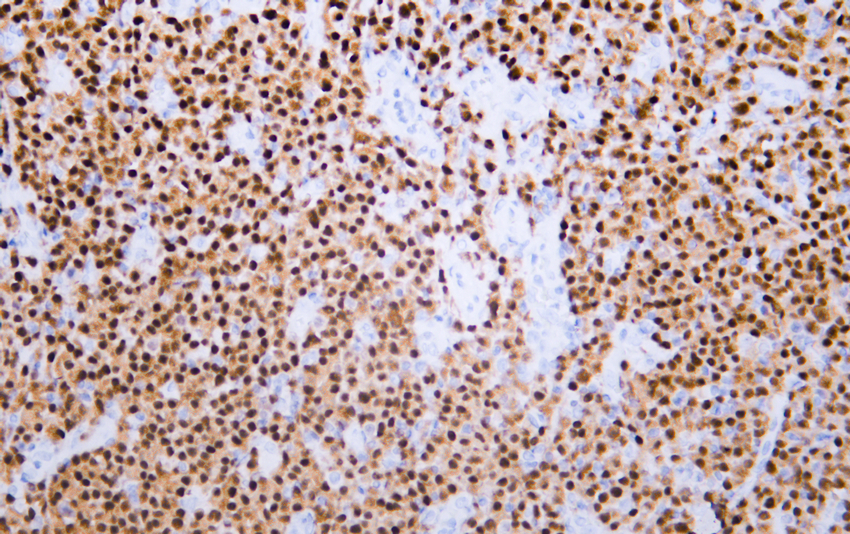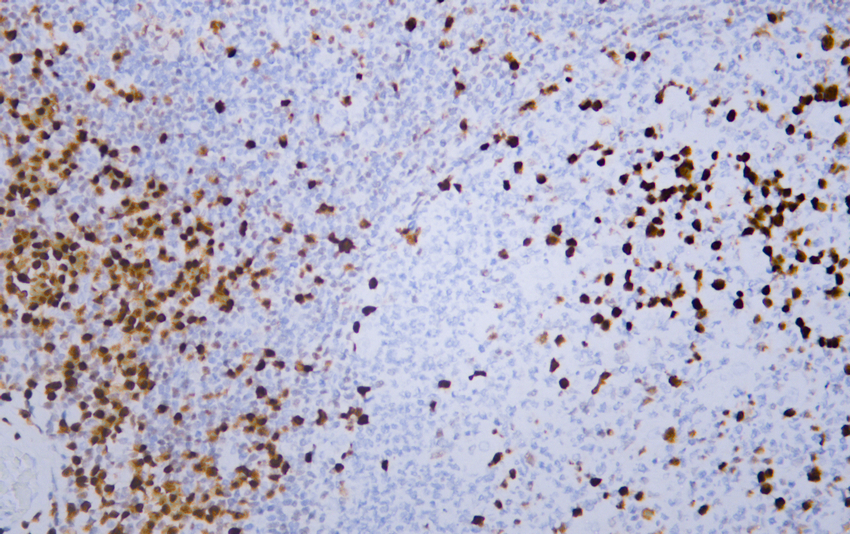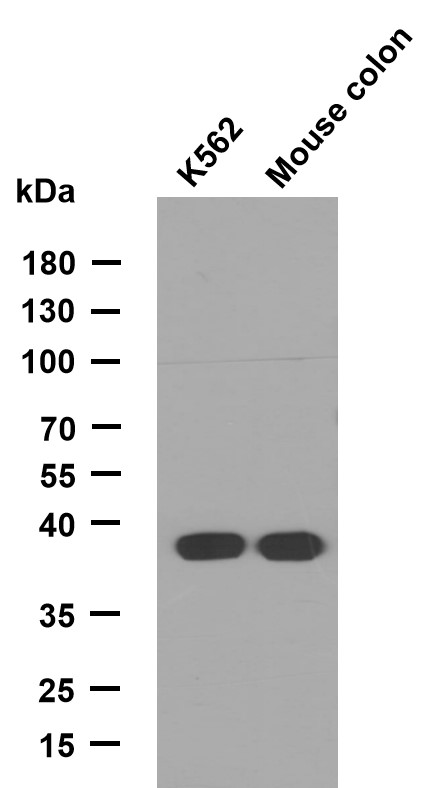IRF-4/MUM1 (ABT080) mouse mAb
- Catalog No.:YM6893
- Applications:IHC;ELISA
- Reactivity:Human;
- Target:
- MUM1
- Fields:
- >>Th17 cell differentiation
- Gene Name:
- IRF4 MUM1
- Protein Name:
- MUM1
- Human Gene Id:
- 3662
- Human Swiss Prot No:
- Q15306
- Immunogen:
- Synthesized peptide derived from human MUM1 AA range: 350-451
- Specificity:
- The antibody can specifically recognize human MUM1 protein.
- Formulation:
- PBS, 50% glycerol, 0.05% Proclin 300, 0.05%BSA
- Source:
- Mouse, Monoclonal/IgG1, kappa
- Dilution:
- IHC 1:200-400. ELISA 1:500-5000
- Purification:
- The antibody was affinity-purified from ascites by affinity-chromatography using specific immunogen.
- Storage Stability:
- -15°C to -25°C/1 year(Do not lower than -25°C)
- Other Name:
- Interferon regulatory factor 4 (IRF-4;Lymphocyte-specific interferon regulatory factor;LSIRF;Multiple myeloma oncogene 1;NF-EM5)
- Molecular Weight(Da):
- 52kD
- Observed Band(KD):
- 52kD
- Background:
- The protein encoded by this gene belongs to the IRF (interferon regulatory factor) family of transcription factors, characterized by an unique tryptophan pentad repeat DNA-binding domain. The IRFs are important in the regulation of interferons in response to infection by virus, and in the regulation of interferon-inducible genes. This family member is lymphocyte specific and negatively regulates Toll-like-receptor (TLR) signaling that is central to the activation of innate and adaptive immune systems. A chromosomal translocation involving this gene and the IgH locus, t(6;14)(p25;q32), may be a cause of multiple myeloma. Alternatively spliced transcript variants have been found for this gene. [provided by RefSeq, Aug 2010],
- Function:
- disease:A chromosomal aberration involving IRF4 may be a cause of multiple myeloma [MIM:254500]. Translocation t(6;14)(p25;q32) with the IgH locus.,function:Transcriptional activator. Binds to the interferon-stimulated response element (ISRE) of the MHC class I promoter. Binds the immunoglobulin lambda light chain enhancer, together with PU.1. Probably plays a role in ISRE-targeted signal transduction mechanisms specific to lymphoid cells.,induction:Not induced by interferons.,similarity:Belongs to the IRF family.,similarity:Contains 1 tryptophan pentad repeat DNA-binding domain.,subunit:Interacts with SPIB and DEF6.,tissue specificity:Lymphoid cells.,
- Subcellular Location:
- Nuclear
- Expression:
- Lymphoid cells.
- June 19-2018
- WESTERN IMMUNOBLOTTING PROTOCOL
- June 19-2018
- IMMUNOHISTOCHEMISTRY-PARAFFIN PROTOCOL
- June 19-2018
- IMMUNOFLUORESCENCE PROTOCOL
- September 08-2020
- FLOW-CYTOMEYRT-PROTOCOL
- May 20-2022
- Cell-Based ELISA│解您多样本WB检测之困扰
- July 13-2018
- CELL-BASED-ELISA-PROTOCOL-FOR-ACETYL-PROTEIN
- July 13-2018
- CELL-BASED-ELISA-PROTOCOL-FOR-PHOSPHO-PROTEIN
- July 13-2018
- Antibody-FAQs
- Products Images

- Human colon tissue was stained with Anti-MUM1 (ABT080) Antibody

- Human diffuse large B-cell lymphoma tissue was stained with Anti-MUM1 (ABT080) Antibody

- Human diffuse large B-cell lymphoma tissue was stained with Anti-MUM1 (ABT080) Antibody

- Human tonsil tissue was stained with Anti-MUM1 (ABT080) Antibody



